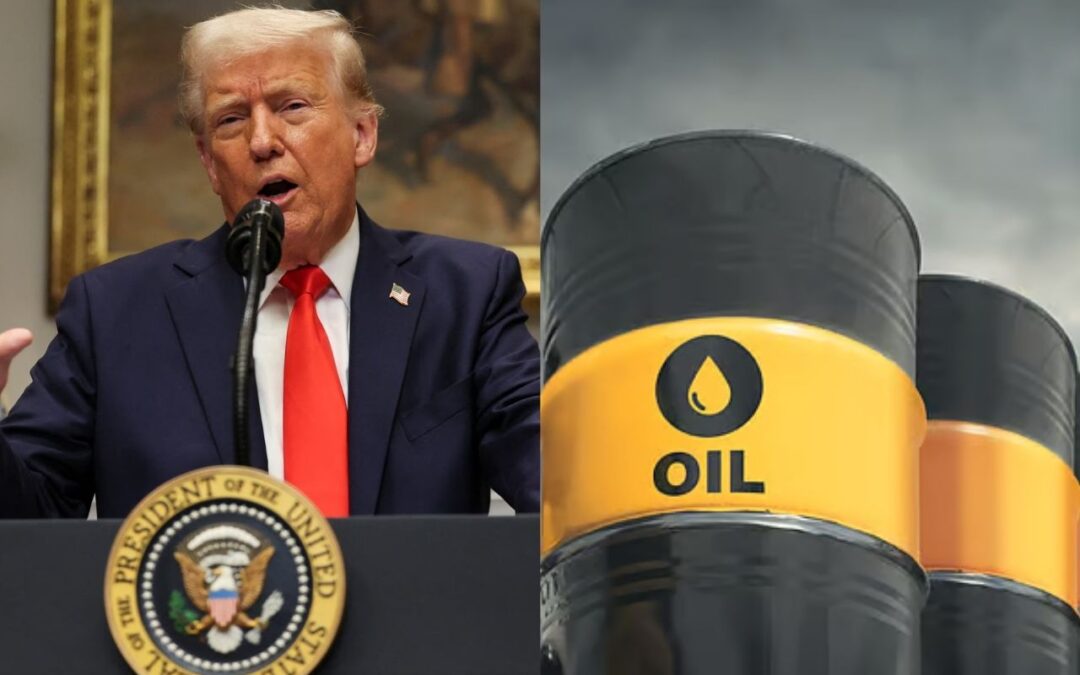President Donald Trump has dropped a potential bombshell on world oil markets. Standing beside NATO’s Mark Rutte, Trump declared severe “secondary tariffs.” These 100% levies target countries buying Russian exports if no Ukraine peace deal emerges within 50 days.
Expressing deep disappointment with Vladimir Putin, Trump set a hard September deadline. This drastic move signals a sharp turn in his Ukraine strategy. Global leaders and energy traders instantly snapped to attention. The clock is ticking towards potential chaos.
What is Trump’s end goal?
Donald Trump has repeatedly claimed he could end the Russia-Ukraine conflict within 24 hours, aiming to showcase strong leadership and fulfil his peace-focused campaign promise. His stance is shaped by strategic goals: cutting U.S. aid to Ukraine, restoring economic ties with Russia, and avoiding a prolonged conflict. However, his tone has recently shifted, expressing frustration with Putin’s aggression and Ukraine’s unwillingness to compromise. Trump has even threatened tariffs and sanctions to push Russia toward negotiations.
Trump aims to force Russia into peace talks swiftly. He clearly expects tangible results within weeks. His frustration with Putin’s prolonged war boiled over publicly. As a result, he’s wielding economic weapons previously used against Iran and Venezuela. These secondary tariffs punish nations enabling Russian trade. Specifically, they target buyers of Russian oil, propping up Moscow’s war chest. Trump believes severe economic pain will compel Russian concessions. Ultimately, he seeks a decisive end to the Ukraine conflict on his terms.
Major Importers Of Russian Oil
Several powerful economies heavily rely on discounted Russian crude. China stands as the absolute top buyer, taking nearly half (47%) of Russia’s exports. India follows closely in second place. India’s imports have skyrocketed by 2,100% to $51.8 billion since the war began.
Turkey also features prominently, with fossil fuel purchases spiking in mid-2025. Furthermore, some EU nations, like Hungary and Slovakia, still need pipeline oil. Many others, including Brazil, the UAE, Saudi Arabia, and Egypt, also import significant amounts. This oil fuels cars, powers factories, heats homes, and makes plastics globally. One key thing is nations like India and Turkey refine it and then export products worldwide. This “refining loophole” indirectly sends Russian oil back to the West.
Short-term Impact
If tariffs hit September 1st, expect instant, severe global disruption. Crude oil prices would likely surge past $100 per barrel rapidly. Brent crude could even reach $110-$120 swiftly. Why? Russia supplies roughly 10% of globally traded crude. Suddenly, major buyers like China and India face impossible choices: pay double for Russian oil or find scarce alternatives fast.
Either path means massive cost increases. Therefore, gasoline, diesel, and heating fuel prices will jump everywhere. Inflation fears would grip importing nations immediately. Affected countries might quickly impose retaliatory tariffs too. The global stock markets would likely plunge amidst the uncertainty. Businesses and consumers worldwide would feel the instant financial sting.
The Global Energy Reset
Forced diversification would reshape energy flows permanently. China and India must urgently find new suppliers like Saudi Arabia. They’ll also boost domestic output and renewable investments faster. Russia faces potential economic disaster long-term. Oil funds over half its exports and 16% of GDP in 2024. Losing major clients could cripple its budget, forcing military cuts.
Geopolitically, expect stronger non-Western alliances opposing US pressure. China, India, and Russia might forge tighter bonds. However, US ties with strategic partners like India could fracture badly. Trade wars might escalate, disrupting vital supply chains further. Moreover, sustained high energy costs will fuel lasting global inflation. Economic growth could stall significantly across many nations.
Oil Prices
Prices will stay elevated for years, reshaping markets. Initially, expect extreme volatility and record highs. Supply simply cannot replace lost Russian barrels overnight. OPEC+ and US shale producers will ramp up, but slowly. Their higher production costs mean prices settle well above pre-tariff levels.
A new normal of $85-$100 per barrel for 1-3 years might be coming. High costs will eventually curb demand, easing pressure slightly. Electric vehicles and renewables gain appeal faster with expensive oil. Nevertheless, consumers face persistently higher fuel and goods prices. Energy security concerns will dominate national policies globally. The world enters a prolonged period of expensive energy.
Wider Global Ripple Effects
No nation escapes the consequences untouched. European allies reliant on Russian pipelines face renewed economic pain. Developing nations struggle most with soaring import bills. Global shipping costs will rise as trade routes reconfigure chaotically. Russia might deepen reliance on its shadow fleet of tankers. Environmental progress could stumble if cheaper coal replaces oil in the short term. On the other hand, green energy investments might accelerate dramatically. Diplomatic channels will buzz with frantic negotiation attempts. The risk of a broader economic recession becomes very real. Stability hangs in the balance for many vulnerable regions.
The Next 50 Days
Trump’s 50-day ultimatum creates a precarious waiting game. Markets are hoping talks avert disaster will happen soon. If genuine peace remains unachievable after years of war. Countries like India will be looking into potential US tariff exemptions. Simultaneously, China might calculate the cost of defiance versus cooperation. For this to stop, Russia must weigh battlefield gains against economic ruin.
September 1st approaches with alarming speed. The decisions made in the coming weeks will echo through the global economy for years. One thing is certain: the world cannot afford business as usual. The stakes for energy security and global stability have never been higher.
Written By Fazal Ul Vahab C H


